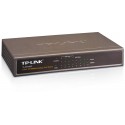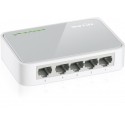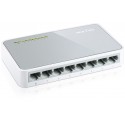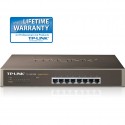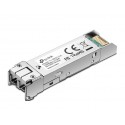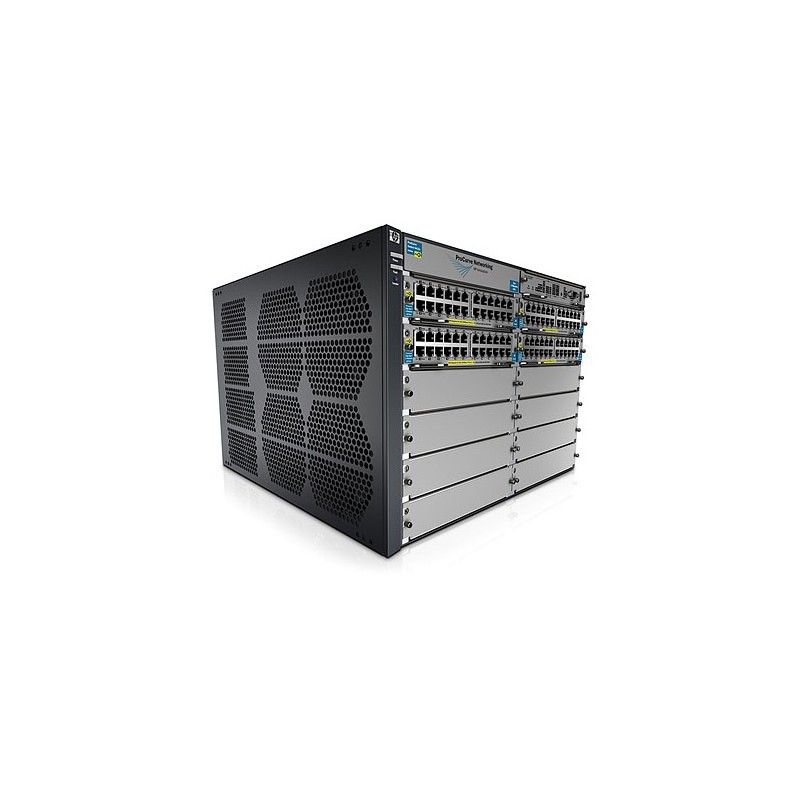
The HP 5400 zl Switch Series consists of advanced intelligent switches in the HP modular chassis product line, which includes 6-slot and 12-slot chassis and associated zl modules and bundles. The foundation for the switch series is a purpose-built, programmable ProVision ASIC that allows the most demanding networking features, such as Quality of Service (QoS) and security, to be implemented in a scalable yet granular fashion. With 10/100, Gigabit Ethernet, and 10 Gigabit Ethernet interfaces; choice of PoE+ and non-PoE; integrated Layer 3 features; and HP AllianceOne solutions, the 5400 zl switch series offers excellent investment protection, flexibility, and scalability, as well as ease of deployment, operation, and maintenance.
Software-defined networking.
OpenFlow: is a key technology that enables software-defined networking by allowing the separation of data (packet forwarding) and control (routing decision) paths.
Quality of Service (QoS).
Advanced classifier-based QoS: classifies traffic using multiple match criteria based on Layer 2, 3, and 4 information; applies QoS policies such as setting priority level and rate limit to selected traffic on a per-port or per-VLAN basis. Layer 4 prioritization: enables prioritization based on TCP/UDP port numbers. Traffic prioritization: allows real-time traffic classification into eight priority levels mapped to eight queues. Bandwidth shaping: Port-based rate limiting: provides per-port ingress-/egress-enforced increased bandwidth. Classifier-based rate limiting: uses an access control list (ACL) to enforce increased bandwidth for ingress traffic on each port. Reduced bandwidth: provides per-port, per-queue egress-based reduced bandwidth. Class of Service (CoS): sets the IEEE 802.1p priority tag based on IP address, IP Type of Service (ToS), Layer 3 protocol, TCP/UDP port number, source port, and DiffServ.
Management.
Remote intelligent mirroring: mirrors selected ingress/egress traffic based on ACL, port, MAC address, or VLAN to a local or remote HP 8200 zl, 6600, 6200 yl, 5400 zl, or 3500 Switch located anywhere on the network. RMON, XRMON, and sFlow v5: provide advanced monitoring and reporting capabilities for statistics, history, alarms, and events. IEEE 802.1AB Link Layer Discovery Protocol (LLDP): advertises and receives management information from adjacent devices on a network, facilitating easy mapping by network management applications. Uni-Directional Link Detection (UDLD): monitors a cable between two switches and shuts down the ports on both ends if the cable is broken, turning the bidirectional link into a unidirectional one; this prevents network problems such as loops. Management simplicity: provides common software features and CLI implementation across all HP ProVision-based switches (including the zl and yl switches).
Connectivity.
IEEE 802.3az Energy Efficient Ethernet: lowers power consumption in periods of low link usage (supported on v2 zl 10/100/1000 and 10/100 modules). IEEE 802.3af Power over Ethernet (PoE): provides up to 15.4 W per port to IEEE 802.3af-compliant PoE-powered devices such as IP phones, wireless access points, and security cameras. IEEE 802.3at Power over Ethernet Plus: provides up to 30 W per port to IEEE 802.3 for PoE- and PoE+-powered devices, such as video IP phones, IEEE 802.11n wireless access points, and advanced pan/zoom/tilt security cameras.
High-speed, high-capacity architecture: 1 Tbps crossbar switching fabric provides intra-module and inter-module switching with 585.6 million pps throughput on the purpose-built ProVision ASICs. Selectable queue configurations: allows for increased performance by selecting the number of queues and associated memory buffering that best meet the requirements of the network applications.
Virtual Router Redundancy Protocol: allows groups of two routers to dynamically back each other up to create highly available routed environments. IEEE 802.1s Multiple Spanning Tree Protocol: provides high link availability in multiple VLAN environments by allowing multiple spanning trees; encompasses IEEE 802.1D Spanning Tree Protocol and IEEE 802.1w Rapid Spanning Tree Protocol. IEEE 802.3ad Link Aggregation Control Protocol (LACP) and HP port trunking: support up to 144 trunks, each with up to eight links (ports) per trunk. Distributed trunking: enables loop-free and redundant network topology without using Spanning Tree Protocol; allows a server or switch to connect to two switches using one logical trunk for redundancy and load sharing. Optional redundant power supply (HP 5400 series): provides uninterrupted power and allows hot-swapping of the redundant power supplies when installed.
VLAN support and tagging: supports the IEEE 802.1Q standard and 2,048 VLANs simultaneously. IEEE 802.1v protocol VLANs: isolate select non-IPv4 protocols automatically into their own VLANs. GARP VLAN Registration Protocol: allows automatic learning and dynamic assignment of VLANs. IEEE 802.1ad Q-in-Q: increases the scalability of an Ethernet network by providing a hierarchical structure; connects multiple LANs on a high-speed campus or metro network. MAC-based VLAN: provides granular control and security; uses RADIUS to map a MAC address/user to specific VLANs (requires v2 modules).
Software-defined networking.
OpenFlow: is a key technology that enables software-defined networking by allowing the separation of data (packet forwarding) and control (routing decision) paths.
Quality of Service (QoS).
Advanced classifier-based QoS: classifies traffic using multiple match criteria based on Layer 2, 3, and 4 information; applies QoS policies such as setting priority level and rate limit to selected traffic on a per-port or per-VLAN basis. Layer 4 prioritization: enables prioritization based on TCP/UDP port numbers. Traffic prioritization: allows real-time traffic classification into eight priority levels mapped to eight queues. Bandwidth shaping: Port-based rate limiting: provides per-port ingress-/egress-enforced increased bandwidth. Classifier-based rate limiting: uses an access control list (ACL) to enforce increased bandwidth for ingress traffic on each port. Reduced bandwidth: provides per-port, per-queue egress-based reduced bandwidth. Class of Service (CoS): sets the IEEE 802.1p priority tag based on IP address, IP Type of Service (ToS), Layer 3 protocol, TCP/UDP port number, source port, and DiffServ.
Management.
Remote intelligent mirroring: mirrors selected ingress/egress traffic based on ACL, port, MAC address, or VLAN to a local or remote HP 8200 zl, 6600, 6200 yl, 5400 zl, or 3500 Switch located anywhere on the network. RMON, XRMON, and sFlow v5: provide advanced monitoring and reporting capabilities for statistics, history, alarms, and events. IEEE 802.1AB Link Layer Discovery Protocol (LLDP): advertises and receives management information from adjacent devices on a network, facilitating easy mapping by network management applications. Uni-Directional Link Detection (UDLD): monitors a cable between two switches and shuts down the ports on both ends if the cable is broken, turning the bidirectional link into a unidirectional one; this prevents network problems such as loops. Management simplicity: provides common software features and CLI implementation across all HP ProVision-based switches (including the zl and yl switches).
Connectivity.
IEEE 802.3az Energy Efficient Ethernet: lowers power consumption in periods of low link usage (supported on v2 zl 10/100/1000 and 10/100 modules). IEEE 802.3af Power over Ethernet (PoE): provides up to 15.4 W per port to IEEE 802.3af-compliant PoE-powered devices such as IP phones, wireless access points, and security cameras. IEEE 802.3at Power over Ethernet Plus: provides up to 30 W per port to IEEE 802.3 for PoE- and PoE+-powered devices, such as video IP phones, IEEE 802.11n wireless access points, and advanced pan/zoom/tilt security cameras.
High-speed, high-capacity architecture: 1 Tbps crossbar switching fabric provides intra-module and inter-module switching with 585.6 million pps throughput on the purpose-built ProVision ASICs. Selectable queue configurations: allows for increased performance by selecting the number of queues and associated memory buffering that best meet the requirements of the network applications.
Virtual Router Redundancy Protocol: allows groups of two routers to dynamically back each other up to create highly available routed environments. IEEE 802.1s Multiple Spanning Tree Protocol: provides high link availability in multiple VLAN environments by allowing multiple spanning trees; encompasses IEEE 802.1D Spanning Tree Protocol and IEEE 802.1w Rapid Spanning Tree Protocol. IEEE 802.3ad Link Aggregation Control Protocol (LACP) and HP port trunking: support up to 144 trunks, each with up to eight links (ports) per trunk. Distributed trunking: enables loop-free and redundant network topology without using Spanning Tree Protocol; allows a server or switch to connect to two switches using one logical trunk for redundancy and load sharing. Optional redundant power supply (HP 5400 series): provides uninterrupted power and allows hot-swapping of the redundant power supplies when installed.
VLAN support and tagging: supports the IEEE 802.1Q standard and 2,048 VLANs simultaneously. IEEE 802.1v protocol VLANs: isolate select non-IPv4 protocols automatically into their own VLANs. GARP VLAN Registration Protocol: allows automatic learning and dynamic assignment of VLANs. IEEE 802.1ad Q-in-Q: increases the scalability of an Ethernet network by providing a hierarchical structure; connects multiple LANs on a high-speed campus or metro network. MAC-based VLAN: provides granular control and security; uses RADIUS to map a MAC address/user to specific VLANs (requires v2 modules).
| AC input frequency | 50/60 Hz |
| AC input voltage | 100-240 V |
| Colour of product | Grey |
| Depth | 450.9 mm |
| Dimensions (WxDxH) | 450.9 x 444.5 x 307.3 mm |
| Electromagnetic compatibility | FCC Class A; VCCI Class A; EN 55022/CISPR 22 Class A |
| Form factor | 7U |
| Heat dissipation | 4900 BTU/h |
| Height | 307.3 mm |
| I/O ports | 12 open module slots; Supports a maximum of 96 10-GbE ports or 288 autosensing 10/100/1000 ports or 288 mini-GBICs, or a combination |
| Input frequency | 50 - 60 Hz |
| Input voltage | 100-127/200-240 VAC |
| Latency | 1000 Mb Latency: < 3.7 µs (FIFO 64-byte packets); 10 Gbps Latency: < 2.1 µs (FIFO 64-byte packets) |
| Latency (10 Gbps) | 2.1 µs |
| MAC address table | 64000 entries |
| Management platform | HP PCM+; HP PCM (included); command-line interface; Web browser; configuration menu; out-of-band management (serial RS-232C) |
| Mounting | Mounts in an EIA-standard 19 in. telco rack or equipment cabinet (hardware included); horizontal surface mounting only |
| Networking standards | EN: EN55024, CISPR 24; ESD: IEC 61000-4-2; 4 kV CD, 8 kV AD; Radiated: IEC 61000-4-3; 3V/m; EFT/Burst: IEC 61000-4-4; 1.0 kV (power line), 0.5 kV (signal line); Surge: IEC 61000-4-5; 1 kV/2 kV AC; Conducted: IEC 61000-4-6; 3V; Power frequency magnetic fie |
| Operating altitude | 0 - 3000 m |
| Operating relative humidity (H-H) | 15 - 95 % |
| Operating relative humidity range | 15 to 95 @ 131°F |
| Operating temperature (T-T) | 0 - 55 °C |
| Operating temperature range (T-T) | 0 - 55 °C |
| Power requirements | Chassis ships without power supplies. Four power supply slots are available; three different power supplies are available. See power supply products for additional specifications.; Power supplies must be ordered separately. Two power supplies are required |
| Rack mounting | Yes |
| Safety | CSA 22.2 No. 60950; UL 60950; IEC 60950; EN 60950 |
| Source data-sheet | Icecat.biz |
| Storage relative humidity (H-H) | 15 - 95 % |
| Storage relative humidity range | 15 to 95 @ 149°F |
| Storage temperature (T-T) | -40 - 70 °C |
| Storage temperature range (T-T) | -40 - 70 °C |
| Supported network protocols | RFC 1591 DNS (client); HTML and telnet management; IEEE 802.1ad Q-in-Q (Premium License); IEEE 802.1D MAC Bridges; IEEE 802.1p Priority; IEEE 802.1Q VLANs; IEEE 802.1s Multiple Spanning Trees; IEEE 802.1v VLAN classification by Protocol and Port; IEEE 802 |
| Switching capacity | 758.4 Gbit/s |
| Throughput | 564.2 Mpps |
| Weight | 15850 g |
| Width | 444.5 mm |

